- $5 fall detection
- Smartwatch with fall detection
- 30-day trial period
LifeFone Medical Alert Review 2025: Affordable Fall Detection and On-the-Go Systems
Key Takeaways
- LifeFone offers at-home, on-the-go, and smartwatch medical alert systems that connect to a 24/7 monitoring center.
- Monthly prices range from $24.95–$47.95, depending on the package you choose.
- Fall detection is an additional $5 per month with most packages.
- Optional add-ons include check-in services, medication reminders, and GPS location tracking.
Medical alert systems, like LifeFone, connect you with emergency responders and caregivers after a fall or during a medical event or other emergency. Access to immediate help with the push of a button can provide peace of mind for you and your loved ones, allowing you to go about your days with fewer worries.
In this LifeFone review, we’ll examine the benefits and drawbacks of LifeFone medical alert systems and share our hands-on testing experience.
About LifeFone
LifeFone was founded in 1976, making it one of the first medical alert system companies in the United States. Today, the company offers several medical alert systems for various activity levels and lifestyles. Choose from an at-home system, compact on-the-go devices, and even a smartwatch.
All packages, including the smartwatch, have optional fall detection. While a medical alert watch with fall detection is impressive, the price for fall detection is one of the most affordable in the industry at $5 per month. But be aware that research from 2021 [1]Javier González-Cañete, Francisco and Casilari, Eduardo. A Feasibility Study of the Use of Smartwatches in Wearable Fall Detection Systems. Sensors. March 23, 2021. Found on the internet at https://www.mdpi.com/1424-8220/21/6/2254. and 2023 [2]Lee, Yongkuk, et al. Experimental Study: Deep Learning-Based Fall Monitoring among Older Adults with Skin-Wearable Electronics. Sensors. March 2023. Found on the internet at https://www.mdpi.com/1424-8220/23/8/3983. shows fall detection devices are most accurate when worn around the neck than on the wrist.
Why you can trust our expert review
Our team spent more than 2,500 hours conducting in-depth research on medical alert systems. During our process, we:
- Engaged in ongoing independent research
- Consulted with licensed adult caregivers, doctors, and nurse practitioners who specialize in older adult care
- Mystery shopped 13 medical alert system brands
- Surveyed 1,000 medical alert system users
- Tested various medical alert systems
- Read hundreds of verified customer reviews from trusted third parties, such as Better Business Bureau (BBB) and Trustpilot
Read more about our medical alert systems review methodology.
Why LifeFone is one of our top picks
LifeFone is featured in our best medical alert system review and was selected for the following reasons:
- Quarterly and annual subscription discounts
- Price lock that guarantees the monthly price won’t increase
- Lifetime warranty for manufacturer defects
- No activation or equipment fees
- $5 per month fall detection for most systems
We tested three LifeFone packages during our medical alert system testing summit: the At-Home & On-the-Go bundle, VIPx®, and VIP Active®.

Pros and cons of LifeFone
Table 1 Comparison of LifeFone medical alert systems, as of 2025
| At-Home Landline | At-Home Cellular | At-Home & On-the-Go VIPx® | At-Home & On-the-Go VIP Active® | At-Home & On-the-Go Bundle | At-Home & On-the-Go Safe Watch Active® | |
|---|---|---|---|---|---|---|
| Starting monthly fee | $29.95 | $34.95 | $43.95 | $41.95 | $43.95 | $47.95 |
| Equipment fee | $0 | $0 | $0 | $0 | $0 | $0 |
| Activation fee | $0 | $0 | $0 | $0 | $0 | $0 |
| Device type | At-home | At-home | On-the-go | On-the-go | At-home, on-the-go | On-the-go |
| Device range (feet) | 1,300 | 1,300 | Unlimited | Unlimited | 1,400 | Unlimited |
| Connection type | Landline | AT&T cellular | AT&T or Verizon cellular | AT&T cellular | AT&T or Verizon cellular | AT&T cellular |
| Battery life | 32 hours | 32 hours | Up to 10 days | Up to 5 days | Up to 5 days | Up to 24 hours |
| Location tracking | No | No | Yes | Yes | Yes | Yes |
| Fall detection (per month) | $5 | $5 | $5 | $5 | $5 | $5 |
| Water resistant | Yes | Yes | Yes | Yes | Yes | Yes |
| Caregiver app | No | No | Yes | No | No | No |
LifeFone devices review
At-Home Landline

- Monthly fee: $29.95
- Device type: At-home
- Device range: 1,300 feet (ft)
- Device dimensions: 8 inches x 8 inches (length x width)
- Device weight: 1 pound (lb)
- Connection type: Landline
- Battery life:
- Base station: 32 hours (backup)
- Help button: Two years
The At-Home Landline is the least expensive LifeFone package at $29.95 per month with a month-to-month payment plan (see our cost section for quarterly and annual payment plan discounts).
The 1,300-foot range between the help button and base station is impressive for a landline system—Medical Guardian is the only other popular brand to offer this landline range. You can press your help button and connect to the monitoring center from more than three football fields away from the base station.
Fall detection ⓘA fall detection necklace has a built-in sensor that detects downward motion. It automatically contacts the monitoring center if it detects a fall, even if the user didn’t press the help button. is available for $5 per month. This is half the price of many of the best medical alert systems with fall detection.
LifeFone also monitors your help button and base station batteries and will send new ones for free when the battery is below 20%. The At-Home Cellular and At-Home and On-the-Go bundle include battery monitoring, too.
We like that you can answer incoming calls to your landline phone on your base station. Just press the base station help button when your landline phone rings, and you’ll be able to enjoy conversations without holding the phone to your ear.
At-Home Cellular

- Monthly fee: $34.95
- Device type: At-home
- Device range: 1,300 ft
- Device dimensions: 8″ L x 8″ W
- Device weight: 1 lb
- Connection type: AT&T cellular
- Battery life:
- Base station: 32 hours (backup)
- Help button: Two years
The At-Home Cellular shares similar features with the At-Home Landline, such as optional fall detection, low-battery notifications, and a 1,300-foot connection range between the help button and base station. The main difference is the connection type.
While 1,300 feet is an impressive range for any at-home system, cellular connection systems often have a longer range than landline systems. We were disappointed there wasn’t an additional 100–200 feet with this package.
For $5 more per month, the At-Home & On-the-Go bundle also includes a base station with cellular connectivity, but it has an extended range (1,400 feet) and a mobile system.
At-Home & On-the-Go VIPx®
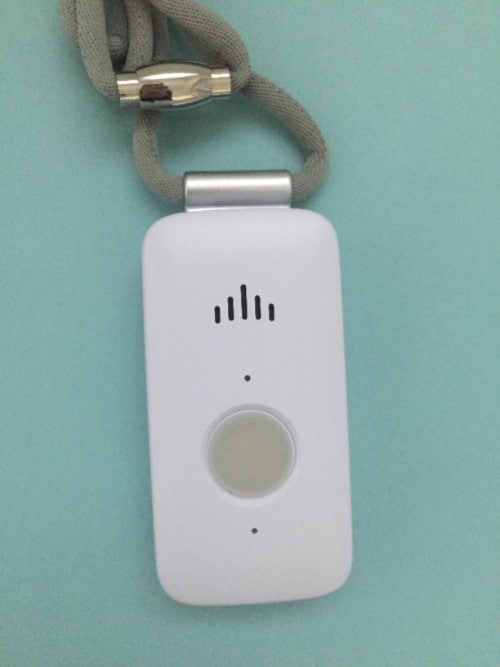
- Monthly fee: $43.95
- Device type: On-the-go, at-home
- Device range: Unlimited
- Device dimensions: 2.7″ L x 1.4″ W
- Device weight: 1.3 oz
- Connection type: AT&T or Verizon cellular, GPS and Wi-Fi enabled
- Battery life: Up to 10 days
- Water resistant: Yes
The VIPx® is a small, lightweight mobile system that’s about the length of a standard lip balm (see comparison image below) and doesn’t weigh much more. Available in black, white, and silver color options, you may not mind wearing the device around your neck—and may even forget it’s there. Our team found the VIPx® light and comfortable when wearing it throughout the day, and we liked that we could also clip it onto a belt.
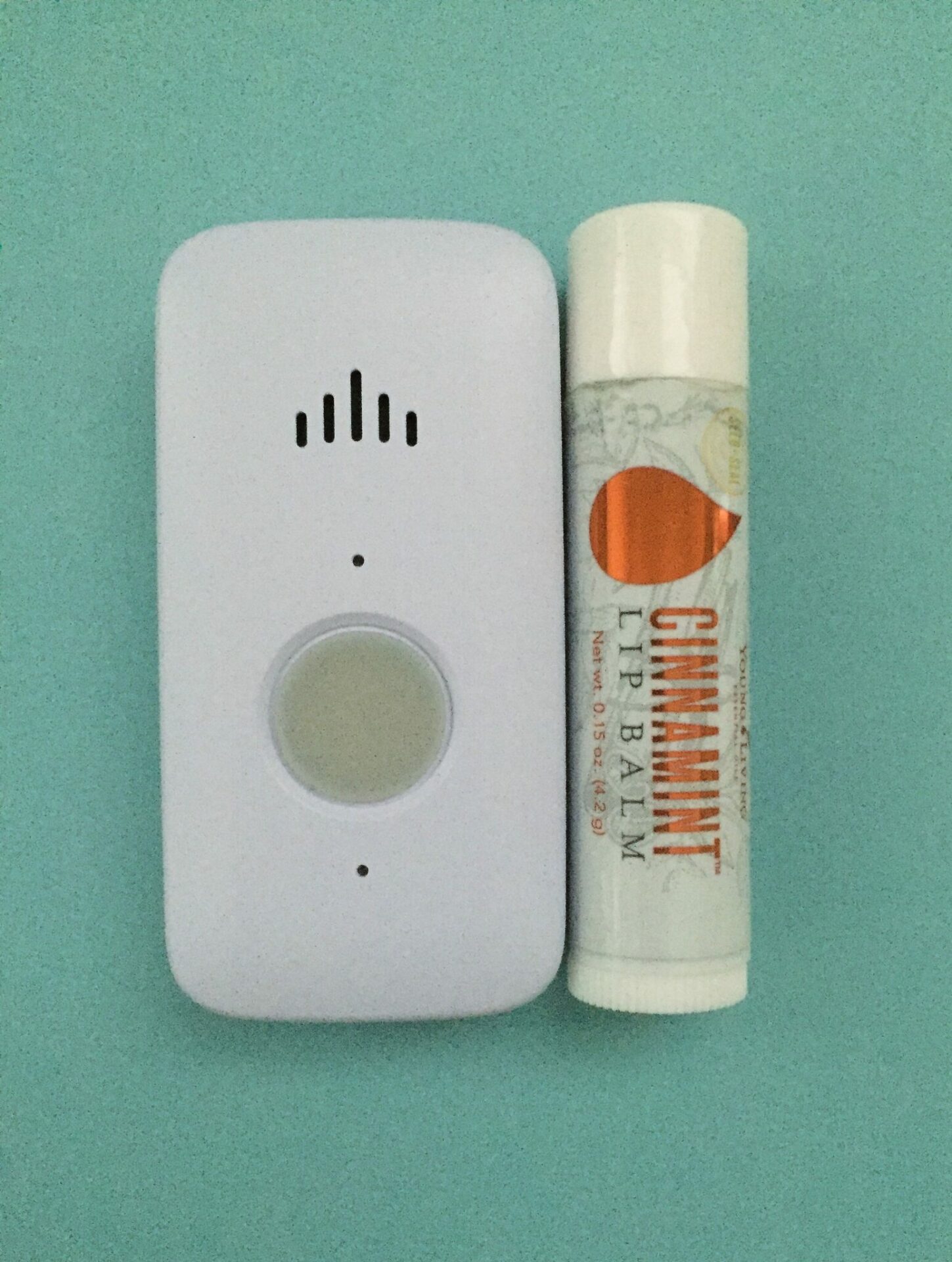
You can contact the monitoring center anywhere with the included cell service (your choice of Verizon or AT&T), so if you spend the majority of your time outside your home, drive independently, or walk around your neighborhood, a mobile system may better fit your lifestyle.
The VIPx® includes a two-way speaker and microphone, allowing you to speak with a monitoring center staff member during an emergency or test call. It also connects to GPS technology (satellites), so monitoring center staff can dispatch emergency services or loved ones to your location.
If you opt for fall detection, it’s built into the device, so you don’t have to worry about wearing a separate fall detection necklace with your VIPx®.
A caregiver app is available specifically for the VIPx®. The app has location and activity tracking, a help button activity log, battery level monitoring, and a step tracker. These are excellent features for loved ones who are more involved in the user’s care, but we don’t like that the app costs $8 per month when most caregiver apps are free or that location tracking is only available through the app.
At-Home & On-the-Go VIP Active®

- Monthly fee: $41.95
- Device type: On-the-go, at-home
- Device range: Unlimited
- Device dimensions: 1.8″ L x 2.4″ W
- Device weight: 1.6 oz
- Connection type: AT&T cellular, GPS, and Wi-Fi enabled
- Battery life: Up to five days
- Water resistant: Yes
The VIP Active® is a compact, on-the-go system available in two color options: black and gold. While the system is 0.3 ounces heavier than the VIPx®, it’s smaller in size and a bit more discreet than the square shape of the VIPx®.
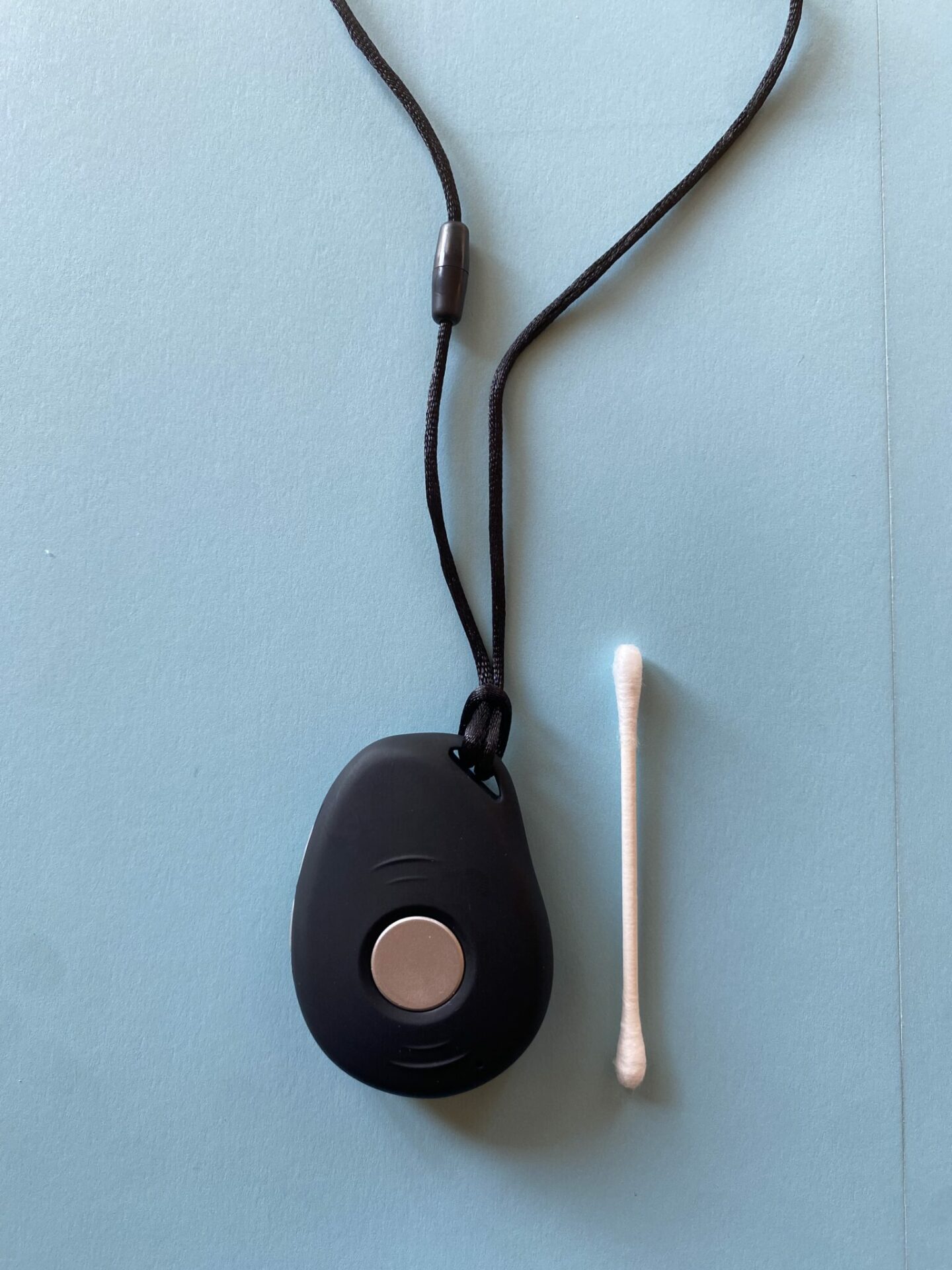
Like the VIPx®, the VIP Active® has a two-way speaker and microphone that connects to the monitoring center, as well as location tracking that uses GPS, Wi-Fi, and cellular technology to pinpoint your location. It has a shorter battery life (up to five days) compared to the VIPx®, and AT&T cellular service is the only cellular service option.
Although the VIP Active® lanyard isn’t adjustable, we thought it was easy to take on and off with the lanyard’s magnetic clasp. The device sat comfortably on our chest.
You’ll never have to guess if your device has a low battery—there is a power light on the side of the VIP Active® that blinks red when the battery is low, as well as an automated voice that announces when the device needs to be charged. This verbal cue is loud enough that it woke up a member of our team in the middle of the night during testing (a good reminder if you forget to charge your device at night).
The VIP Active® doesn’t have a caregiver app, which we consider a major drawback. We do like that on-demand location tracking is still available for the device—even without an app.

Designated caregivers can text “Find (user name)” to 855-999-3224, and they’ll receive an address and link to their loved one’s device location on Google Maps. While we wish there was an optional app for the VIP Active®, some caregivers may prefer finding their loved one’s location via text without logging into and navigating an app.
At-Home & On-the-Go Bundle
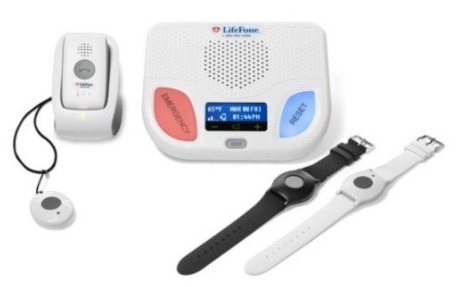
- Monthly fee: $43.95
- Device type: At-home, on-the-go
- Device range:
- 1,400 ft (at-home base and help buttons)
- Unlimited (mobile on-the-go)
- Device dimensions:
- Base station: 8″ L x 8″ W
- Mobile system: 3″ L x 2″ W
- Device weight:
- Base station: 1 lb
- Mobile system: 1.3 oz
- Connection type: AT&T cellular, GPS, and Wi-Fi enabled (mobile system)
- Battery life:
- 30-hour backup battery (at-home)
- Five days (on-the-go)
The LifeFone At-Home & On-the-Go bundle package comes with an at-home base station with a cellular connection, a wearable at-home help button with your choice of a wristband or lanyard, and an on-the-go mobile system. Both systems are unique to this package, which is unusual for medical alert system bundles.
We recommend this package for couples or roommates who would like to be connected to the monitoring center under one account.
The base unit has a 1,400-foot range from the help button and comes with a two-way speaker and optional medication reminders. We didn’t receive instructions for setting up medication reminders when testing this package, and it wasn’t included in our user guide. You can learn more about medication reminders in our add-on services section.
Like the VIPx® and VIP Active®, the LifeFone mobile system works anywhere with a cellular connection. But unlike the other two devices, this mobile system includes a help button (wristband or necklace) with a 600-foot connection range.
If you opt for fall detection with this bundle, it’s double the price compared to every other LifeFone package: $10 per month instead of $5. We would understand this price increase if fall detection was available for the base station and mobile system, but you only receive one fall detection necklace for both systems.
One thing to keep in mind if you’re interested in buying this bundle: it is no longer listed in the LifeFone products menu, but is still available by request, both online and by phone. We spoke to a representative, who explained that because the company has added a new at-home and on-the-go wearable medical alert system that does everything the bundled systems do, this option is no longer being promoted. If you would prefer to have a base system that is AC powered and doesn’t need to be recharged, this bundle could still be a good option for you.
At-Home & On-the-Go Safe Watch Active®
- Monthly fee: $47.95
- Device type: Smartwatch
- Device range: Unlimited
- Device dimensions: 10″ L (including watchband) x 1″ W (watch face)
- Device weight: 2.3 oz
- Connection type: AT&T cellular, GPS and Wi-Fi enabled
- Battery life: Up to 24 hours
- Water resistant: Yes
Usually when opting for a medical alert watch, you have to make the choice between having fall detection or having a sleeker, more discreet device. Some medical alert brands have begun introducing smartwatches with fall detection, including LifeFone. But be aware common wrist movements may trigger a false alarm with fall detection smartwatches.
The At-Home & On-the-Go Safe Watch Active® offers fall detection for $5 per month. You can also reach the monitoring center by pressing the button on the side of the watch face or by triggering fall detection.
Audio and vibrational cues indicate when the watch is turning on and off, contacting the monitoring center, and charging. We like the large watch face and black background with contrasting large white letters, which may aid users with low vision.
You can also track your steps, monitor your heart rate, and check the local weather on your smartwatch. The Safe Watch Active® is one of the most affordable medical alert smartwatches with fall detection. Compare its $49.95 monthly monitoring fee and $0 equipment fee to the UnaliWear Kanega Watch ($69.95 per month plus a $299 one-time equipment fee).
While the Medical Guardian MGMove ($39.95 per month plus a $199.95 equipment fee) and Bay Alarm Medical SOS Smartwatch ($34.95 per month plus a $159 equipment fee) have lower monthly fees than the Safe Watch Active®, they include hefty one-time fees, and the MGMove doesn’t offer fall detection.
One drawback of the LifeFone Safe Watch Active® may be its touch screen, which may be difficult for some older adults to navigate. We’ve covered this topic in previous articles with Christopher Norman, a geriatric nurse practitioner based in New York state.
“As we age, our skin changes. The collagen (a protein) under our skin thins out, and we don’t provide as much oil or sweat,” Norman told us previously. “This accounts not only for wrinkles, but it results in skin that is more dry. If you’ve ever tried to use a touch screen with very dry skin, it doesn’t work as easily.”
How much does a LifeFone medical alert system cost?
Table 2 Comparison of LifeFone package prices, as of 2025
| Monthly subscription | Quarterly subscription (per month) | Annual subscription (per month) | Equipment fee | Shipping fee | |
|---|---|---|---|---|---|
| At-Home Landline | $29.95 | $83.85 ($27.95) | $299.40 ($24.95) | $0 | $16.95 |
| At-Home Cellular | $34.95 | $98.85 ($32.95) | $371.40 ($30.95) | $0 | $16.95 |
| At-Home & On-the-Go VIPx® | $43.95 | $125.85 ($41.95) | $479.40 ($39.95) | $0 | $16.95 |
| At-Home & On-the-Go VIP Active® | $41.95 | $119.85 ($39.95) | $455.40 ($37.95) | $0 | $16.95 |
| At-Home & On-the-Go Bundle | $43.95 | $125.85 ($41.95) | $479.40 ($39.95) | $0 | $16.95 |
| At-Home & On-the-Go Safe Watch Active® | $47.95 | $137.85 ($45.95) | $527.40 ($43.95) | $0 | $16.95 |
The starting $29.95 monthly fee is standard compared to other medical alert system costs. LifeFone doesn’t charge equipment or activation fees, making its monthly prices even more impressive. Even if LifeFone increases its monthly monitoring fees over time, your monthly fee stays the same.
Monthly, quarterly, and annual subscriptions are available, and you’ll save a few dollars each month if you choose a quarterly or annual subscription. But keep in mind you’ll pay more upfront.
The above table shows the full amount you’ll pay quarterly (every three months) or annually (once a year), while the amount in the parentheses is how much that breaks down month-by-month.
On top of the monthly discount, you’ll also get the following perks:
- Quarterly plan: free shipping and one free month of service
- Annual plan: free shipping, free lockbox, and one free month of service
Signing up for anything but a month-by-month plan may feel like a big commitment. Fortunately, LifeFone offers a prorated refund for the months you don’t use if you cancel your subscription, so signing up for a longer subscription may be worth it for the discount. We’ll go into more detail about the cancellation policy in the next section.
Insurance and other coverage
Medical alert systems are not covered by traditional Medicare, but some Medicare Advantage plans may offer full or partial coverage. Check with your insurance provider for full coverage details since coverage varies by plan.
Another option to pay for medical alert system equipment and monthly monitoring fees could be using money in a flexible spending account (FSA) or health savings account (HSA). Note that both have strict limitations: FSA funds can’t be used once you’re retired, and you can’t contribute to an HSA once you’re enrolled in Medicare.

Use NCOA’s BenefitsCheckUp to see potential cost-saving resources and programs that may be available to you in your area.
Another way to save money on your LifeFone medical alert system is through the brand’s referral program. When you refer a family member or friend and they purchase a LifeFone package, you’ll both receive a free month of service.
You can submit your referral by phone (800-331-9198), email (service@lifefone.com), or by filling out the referral form on the LifeFone website. The number of referrals you can submit or the free months of service you can receive when your referrals lead to a purchase is unlimited.
How to purchase a LifeFone medical alert system
You can purchase LifeFone medical alert systems online or over the phone at 800-882-2280. If you’re buying your system online, watch out for the slightly deceiving, “Plans starting as low as” price listed on each product page.

This is the monthly price for the quarterly plan. You’ll click Buy Now to view the monthly plan.
All packages include a 30-day risk-free trial, meaning you’ll receive a full refund (minus shipping) if you return the equipment within 30 days of receiving it.
LifeFone equipment comes with a lifetime warranty covering defects due to manufacturing. This manufacturer warranty is generous compared to most of the top medical alert systems that offer only a one-year manufacturer’s warranty, if any.
If you’re interested in equipment coverage for accidents or theft, review the LifeFone protection plan in the next section.
Returns
You can cancel your LifeFone subscription by calling 800-940-0262 and speaking with a customer service representative. You’ll also sign the notice of cancellation slip that comes with your system and include it in the return package.
Unlike some companies, LifeFone does not pay for return shipping, so you’re responsible for the return shipping costs. Once the company receives your equipment, it will cancel your monitoring center service and you’ll receive a prorated refund for any months not used (this is why we recommend purchasing a quarterly or annual payment plan).
We like that there are no cancellation fees or penalties. Note that add-on accessories, such as a leather carrying case or lockbox, are not eligible for a refund.
Does LifeFone offer a protection plan?
LifeFone offers a protection plan for $5 per month. How is this different from the company’s lifetime warranty? Instead of only replacing defective equipment due to manufacturing, the protection plan replaces lost, stolen, or damaged equipment due to accidents, like drops or spills, as well as damage from heat or humidity.

With a protection plan, you’ll receive expedited equipment repair and replacement after you meet your replacement deductible ($6 for help buttons and $29 for the base station, mobile device, or watch).
You’re eligible for one base unit, mobile system, or watch replacement, as well as two help button replacements during any 12-month period.
Does LifeFone offer fall detection?
LifeFone offers fall detection for all six packages. Fall detection is a popular feature and was the top special feature requested in a survey of 1,000 medical alert system users and caregivers conducted by our team. [3]NCOA Adviser Medical Alert System Survey. 1,000 respondents. Conducted using Pollfish. Launched Nov. 11, 2022.
Fall detection is an additional $5 per month with the following packages:
- At-Home Landline
- At-Home Cellular
- VIPx®
- VIP Active®
- Safe Watch Active®
- At-Home & On-the-Go bundle.
There were no fall detection testing instructions in the LifeFone user guide or setup instructions. We spoke with a customer service representative for testing instructions, and they told us to do the following:
- Swing the necklace by the lanyard four times
- Toss the necklace onto a hard surface, like a table or the floor
- Wait 30 seconds
Once we dropped the necklace on the table, it triggered fall detection. LifeFone fall detection sensors may be sensitive since we accidentally activated fall detection when picking up the necklace from a waist-high desk during testing.
Fall detection does not prevent falls, but it can help you get assistance quickly after a fall. Getting immediate medical attention after a fall can decrease the likelihood of health complications resulting from a “long lie ⓘA long lie occurs when a person falls and is unable to get up from the floor for an hour or more. Long lies have been associated with several types of long-term health complications.” Research shows these may include muscle damage, pneumonia, pressure sores, dehydration, and hypothermia. [4]Guat Cheng Ang, et al. Approach to Falls Among the Elderly in the Community. Singapore Medical Journal. March 2020. Found on the internet at http://www.smj.org.sg/article/approach-falls-among-elderly-community.
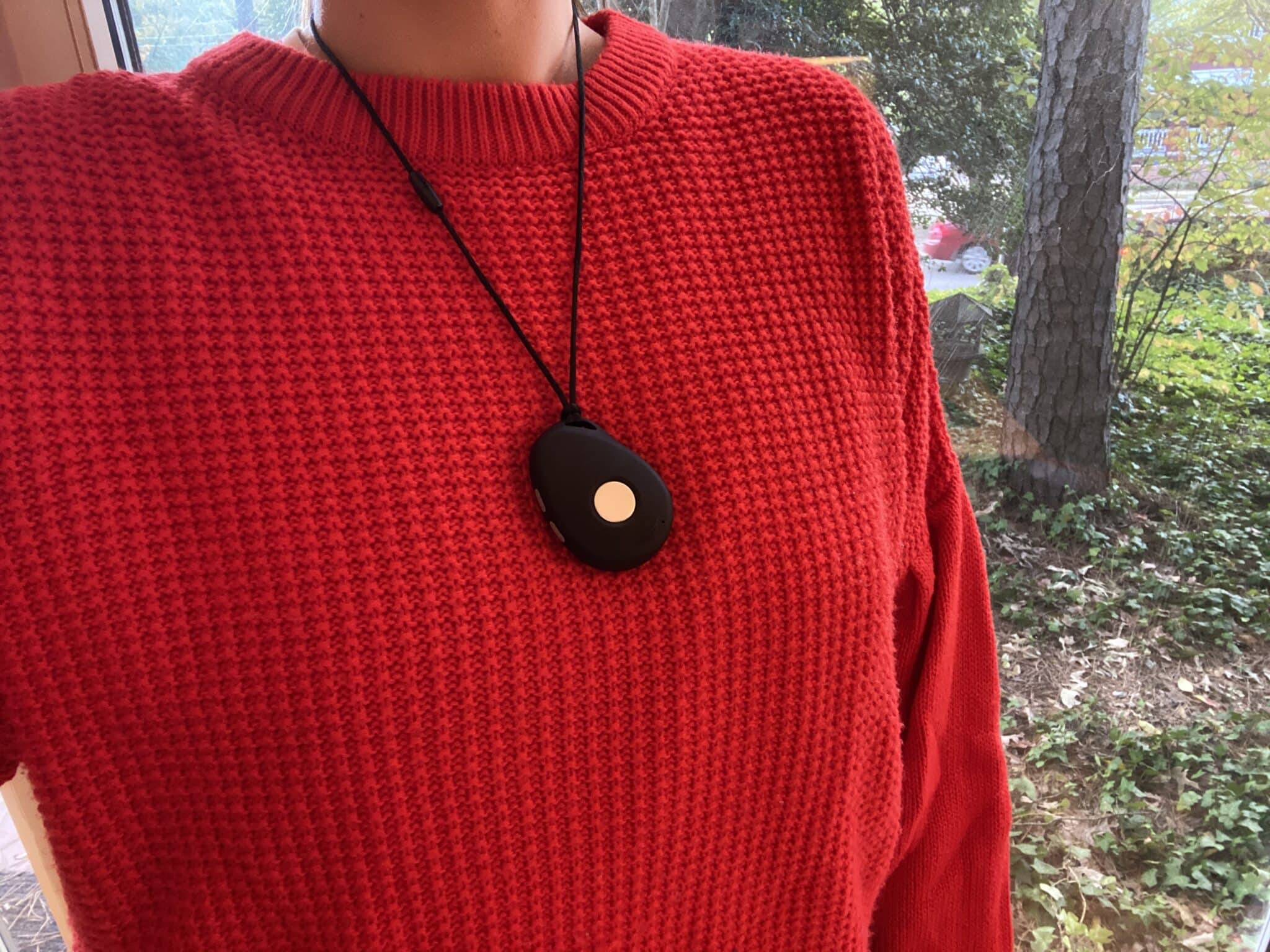
Keep in mind fall detection technology is not yet 100% accurate. A research survey from 2020 found an average accuracy rate of 93% for fall detection devices, but numbers vary. [5]Ramachandran, Karuppiah. A Survey on Recent Advances in Wearable Fall Detection Systems. BioMed Research International. Jan. 13, 2020. Found on the internet at https://www.hindawi.com/journals/bmri/2020/2167160.
Another study [6]Aziz, Omar, et al. Validation of accuracy of SVM-based fall detection system using real-world fall and non-fall datasets. PLoS One. July 2017. Found on the internet at https://journals.plos.org/plosone/article?id=10.1371/journal.pone.0180318. found an accuracy rate of 80%, but a review of 22 studies [7]Broadley, Robert W., et al. Methods for the Real-World Evaluation of Fall Detection Technology: A Scoping Review. Sensors. June 2018. Found on the internet at https://www.mdpi.com/1424-8220/18/7/2060. found that more real-world research is needed for a standard accuracy rate for fall detection systems, especially if different fall detection technology is used in each study.
Use NCOA’s Falls Free CheckUp to assess your or your loved one’s fall risk.
LifeFone add-on services, accessories, and app
We found LifeFone add-on services confusing since some services are bundled in one monthly fee while others are not available for every package.
The LifeFone Caregiver Tools page lists activity assurance, daily check-ins, medication reminders, and location services as its main add-on services.
We’ve summarized add-on services here:
- Activity assurance: This service encourages users to check in with a monitoring center staff member at a set time every day. The base station will beep, and the user will press the button as a check-in. This service is available for At-Home Landline, At-Home Cellular, and At-Home & On-the-Go bundle ($6 per month).
- Daily check-in services: Instead of the user pressing a button to check in with the monitoring center, a monitoring center staff member calls the user on their phone for a daily check-in. This service is available for all packages. You can customize the call to also serve as a daily reminder, such as a reminder to take certain medications or to water a houseplant. You’ll select the time of day for the call ($19 per month).
- Medication reminders: Official medication reminders can be set for the At-Home and On-the-Go bundle base station, but not for the landline or cellular base stations. You’ll need to program the medication reminders through the online caregiver portal. When it’s time for your reminder, the base station announces, “Medication reminder. Please press ‘reset’ to accept.” We don’t like that the reminder doesn’t include the medication type or dosage. Because of that, this service may not be fit for those with memory loss or dementia. If medication reminders are necessary for your loved one, we recommend using the daily check-in call as a detailed medication reminder instead ($6 per month).
- Location services: You can detect the real-time location of your loved one’s mobile system on the online caregiver portal. This service includes 30 location requests per calendar month, and each additional 30 location request is $5. This service is bundled with medication reminders and notification settings ($9 per month).
Add-on accessories
The following accessories are available to add to your package for a one-time fee during checkout:
- Leather carrying case: A black carrying case available for the At-Home and On-the-Go mobile system and VIPx® ($14.95 each)
- Hanging lockbox: A small lockbox ⓘTypically attached to the outside of your home, a medical alert lockbox is a common add-on accessory that stores a house key, giving emergency responders access to the home. that can be attached to a railing or fence ($29.95 each)
- Wall mount master lockbox: A lockbox that can be mounted to a wall ($39.95 each)
- Hanging master lockbox: A large lockbox that can be attached to a railing or fence ($39.95)
- Wall-mounted help button: Attaches to your wall and has a large red HELP button that contacts the monitoring center when you push it (only available for the At-Home Landline, At-Home Cellular, or the At-Home & On-the-Go bundle for $39.95 each)
- Extra help button necklace or wristband: Add extra necklaces or wristbands to the at-home systems and bundled package ($39.95 each)
- Vanity pendant: A gold and silver necklace disguises a help button as a beautiful jewelry piece, but it doesn’t support fall detection (only available for the At-Home Landline and At-Home Cellular systems for $71.95 each)
LifeFone caregiver app and online portal
The VIPx® Caregiver Mobile App is only available for one system, the VIPx®, and costs $8 per month. These are huge downsides since most medical alert system apps are free and work with all devices.
The app allows caregivers to do the following:
- View the device’s current location
- Get notifications for every help button press
- Track the user’s daily steps
- Check and monitor the user’s first motion of the day
- Receive low battery or power off notifications
- Ring the VIPx® if it’s misplaced
The caregiver app has three navigation categories at the bottom of the screen: Home, Location, and Device.

The main function of the categories:
- Home: View device location, step tracker, the first motion of the day, battery level, and whether the device is connected to the cellular network.
- Location: See where the device is on a live map. You can update the location by pressing “refresh” and tapping the pin on the map to get more location details.
- Device: Enter and view device settings. You can change the daily step goal and adjust the first motion target time. App notifications for button presses, fall detection, low battery, power off, and first motion are also managed here.

You’ll also have access to an online account portal, but we confirmed with a customer service representative that this is mainly for administrative tasks, such as managing billing, emergency contacts, notification settings, and medication reminders.
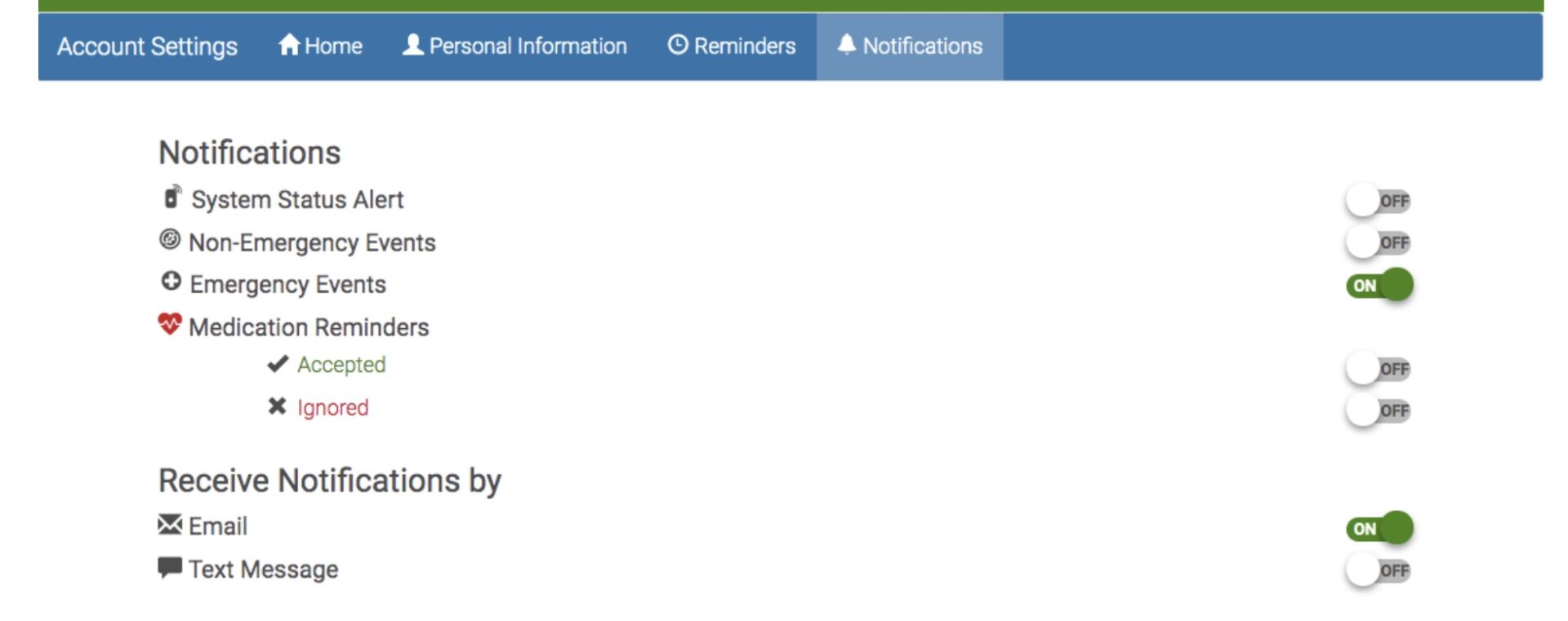
To manage emergency contacts in the portal, the user or primary caregiver fills out an online form with medications, allergies, emergency contacts, physician contact information, and preferred hospital.
We like that you can designate an emergency contact who has a key to your home and whether LifeFone should send email or text notifications to your emergency contact during an emergency.
You can also include details about the following:
- Do not resuscitate (DNR)
- Living will
- Power of attorney
- Home alarm code
- Lockbox code
- Pets
LifeFone customer service and satisfaction
You can contact LifeFone customer service by phone (800-882-2280), by email (info@lifefone.com), or through online chat.
- Customer service phone availability: Monday through Sunday, 8 a.m. to 10 p.m. ET
- Customer service online chat availability: Monday through Friday, 8:30 a.m. to 4:30 p.m. ET
We had an overall good experience with customer service when testing LifeFone medical alert systems. The customer service representatives were friendly, knowledgeable, and able to answer our questions directly.
One issue we experienced was getting placed on a “brief hold” when we called customer service multiple times, with these holds often lasting more than five minutes.
Two different customer service representatives gave conflicting information about the temperature monitoring feature. One representative explained the feature over the phone and told us it was included with the at-home base stations. Another representative told us via online chat that “temperature monitoring is no longer something that is offered with our systems.”
We were impressed with how quickly we received answers when we submitted questions to info@lifefone.com. Both of our questions were answered within the same day.
We recommend this contact method for simple questions about product specifications or features but not for complicated questions or troubleshooting issues.
Table 3 Comparing LifeFone to other top medical alert systems, as of 2025
| LifeFone | MobileHelp | Medical Guardian | Bay Alarm Medical | Lifeline | Life Alert | |
|---|---|---|---|---|---|---|
| Starting monthly cost | $29.95 | $19.95 | $29.95 | $24.95 | $29.95 | $49.95 |
| Device range (ft) | 1,300 | 600–1,400 | 1,300–1,400 | 1,000 | 800 | 800 |
| Connection type | Landline, AT&T or Verizon cellular, | Landline, AT&T cellular | Landline, AT&T or Verizon cellular | Landline, AT&T or Verizon cellular | Landline, cellular | Landline, cellular |
| Fall detection (per month) | $5–$10 | $11 | $10 | $10 | $15 (bundled with package) | N/A |
| On-the-go options | Yes | Yes | Yes | Yes | Yes | Yes |
| Maximum on-the-go battery life | 10 days | 3 days | 5 days | 6 days | 4 days | 10 years |
| Response time (seconds) | 25–50 | 1–15 | 1–15 | 1–15 | N/A | N/A |
| Location tracking | Yes | Yes | Yes | Yes | Yes | Yes |
| Water-resistant | Yes | Yes | Yes | Yes | Yes | Yes |
LifeFone customer reviews
LifeFone has 1.3 out of 5 stars on Better Business Bureau (BBB), but this is based on only three customer reviews. LifeFone responded to all three negative reviews and is accredited by the BBB.
The biggest issues the reviewers touched on were billing issues when trying to cancel their subscription and the fall detection necklace getting damaged after only a few falls.
The company had a much higher rating on Trustpilot: 4.9 out of 5 stars based on 908 reviews. LifeFone is a verified business with an “Excellent” rating, and the company responds to both positive and negative reviews.
A majority of the positive reviews praise the monitoring center’s quick response during an emergency. Multiple reviewers liked how LifeFone kept them in the loop as an emergency contact during a loved one’s emergency.
“Fortunately, I only had one emergency call on my LifeFone and the response was excellent. Someone stayed on the phone until the Fire Department and Paramedics arrived. I was very frightened and the person on the other end did everything she could to keep me calm and informed. That one emergency was enough to convince me that every senior or disabled person should have LifeFone in their home! Thank you for your exceptional service.”
— CATHERINE, VERIFIED CUSTOMER REVIEW (TRUSTPILOT)
“I bought LifeFone for my mother. She has already used it twice, once with the fall detection and once when she pushed the button. A representative from LifeFone contacted me both times. They have been wonderful to work with and I feel much more comfortable about my mother’s safety now that she is wearing her LifeFone necklace.”
— WENDY, VERIFIED CUSTOMER REVIEW (TRUSTPILOT)
Other positive reviews mentioned great customer service and compassionate team members, as well as the helpfulness of the help button’s low battery notifications and free replacements.
Negative reviewers reported issues processing returns, experienced poor customer service, thought the necklaces were uncomfortable, and reported multiple fall detection necklace false alarms.
“Fall detection is so sensitive you can hardly set it down on something soft and it goes off. If walking and it bumps on your chest it goes off. The response call is very good, but I wish they came up with a remote station that can be in two different rooms and not just the one main station. Returned the fall detection pendant and they still are charging me for it. Another call to LifeFone for money back.”
— GARY, VERIFIED CUSTOMER REVIEW (TRUSTPILOT)
Bottom line
LifeFone offers two at-home systems, two mobile systems, a smartwatch, and an at-home and mobile system bundle with monthly monitoring fees ranging from $29.95–$49.95. LifeFone does not charge extra fees for extra equipment or system activation, and fall detection starts at $5 per month—one of the lowest in the industry—for all packages except the bundle.
We like that LifeFone has medical alert systems for both more independent, active users and those who may need more intensive at-home monitoring. It is one of the only top medical alert systems to offer a smartwatch with fall detection.
Several add-on services are available, such as activity monitoring, medication reminders, and location tracking. These services are not available for every package and can quickly add up to a much higher monthly fee.
The VIPx® is the only LifeFone package with a corresponding caregiver app, and it costs an additional $8 per month. If you’re looking for an innovative caregiver app that’s free with your medical alert system, consider Aloe Care Health, Bay Alarm Medical, or Medical Guardian.
Frequently Asked Questions
LifeFone medical alert systems cost $29.95–$47.95 per month, with optional fall detection for $5 per month, depending on the package. Shipping is $16.95 and there are no activation or equipment fees. You can save a few dollars each month by opting for a quarterly or annual subscription.
Yes, we think LifeFone is a good company and included it in our best medical alert systems review. While LifeFone has 1.3 out of 5 stars on Better Business Bureau based on three reviews, the company has 4.9 out of 5 stars on Trustpilot based on 908 customer reviews. When testing LifeFone, we thought the devices were simple to set up, durable, and successfully connected to the monitoring center during all test calls.
LifeFone medical alert systems contact a 24/7 monitoring center using a landline or cellular connection when you press the help button or trigger fall detection. Depending on the situation, the staff member will dispatch emergency services, loved ones, or both to your location.
Yes. LifeFone is better than Life Alert, according to our testing. LifeFone has a longer at-home system range (1,300 feet) than Life Alert (800 feet) and offers fall detection for its at-home, mobile, and smartwatch medical alert systems. Life Alert does not offer fall detection and has many other drawbacks, such as a three-year contract, high monthly fees, pushy sales tactics, and more, which we discuss in our Life Alert review.
No. Medical alert systems are not covered by traditional Medicare (Parts A and B). Some Medicare Advantage plans (Part C) may offer full or partial coverage for LifeFone medical alert systems. Since Medicare Advantage coverage varies by plan, check with your insurance provider for full coverage details.
Have questions about this review? Email us at reviewsteam@ncoa.org.
Sources
- Javier González-Cañete, Francisco and Casilari, Eduardo. A Feasibility Study of the Use of Smartwatches in Wearable Fall Detection Systems. Sensors. March 23, 2021. Found on the internet at https://www.mdpi.com/1424-8220/21/6/2254
- Lee, Yongkuk, et al. Experimental Study: Deep Learning-Based Fall Monitoring among Older Adults with Skin-Wearable Electronics. Sensors. March 2023. Found on the internet at https://www.mdpi.com/1424-8220/23/8/3983
- NCOA Medical Alert System Survey. 1,000 respondents. Conducted using Pollfish. Launched Nov. 11, 2022
- Guat Cheng Ang, et al. Approach to Falls Among the Elderly in the Community. Singapore Medical Journal. March 2020. Found on the internet at http://www.smj.org.sg/article/approach-falls-among-elderly-community
- Ramachandran, Karuppiah. A Survey on Recent Advances in Wearable Fall Detection Systems. BioMed Research International. Jan. 13, 2020. Found on the internet at https://www.hindawi.com/journals/bmri/2020/2167160
- Aziz, Omar, et al. Validation of accuracy of SVM-based fall detection system using real-world fall and non-fall datasets. PLoS One. July 2017. Found on the internet at https://journals.plos.org/plosone/article?id=10.1371/journal.pone.0180318
- Broadley, Robert W., et al. Methods for the Real-World Evaluation of Fall Detection Technology: A Scoping Review. Sensors. June 2018. Found on the internet at https://www.mdpi.com/1424-8220/18/7/2060


